UPDATED: June 2, 2024

The question about whether there are Alligators in the Dallas/Fort Worth metroplex is easy to answer in the affirmative… there certainly are Alligators to be found in DFW. Alligators have been verified to be present in a number of different locations around the metroplex with reliable and repeated observations. In spite of this, the complete story about Alligators in Dallas/Fort Worth continues to be something of an enigma.
Several questions remain about North Texas Alligators, and how they manage to survive in urban areas. One important mystery is why Alligators can be found in certain places, but are absent from locations that appear to have equally attractive and accessible habitat. Surely, there are gaps in the data describing how Alligators are distributed around the metroplex. Are DFW Alligator populations typically isolated, or are these big reptile mobile?
Urban alligators also face a unique set of survival challenges. There are a number of questions concerning how Alligators in Dallas/Fort Worth manage these difficulties. What do they eat? How do they overwinter in North Texas–especially in regards to surviving the brutal cold spells that occasionally settle in over the area? Do they reproduce here? I haven’t seen evidence that they do. Finally, the way Alligators interact with people is of interest. In the country’s 4th largest metropolitan area–a place with well over 7 million residents–have there been any reported attacks on people, pets or livestock?
My goal when putting together this article was simple. I wanted to gather as much information as possible about Alligators in North Texas, and collect that data in a place where it could be updated regularly as new information became available. Certainly not all of the questions about DFW urban Alligators will be answered here, but hopefully this effort will remove some of the mystery surrounding these intriguing animals.
But first, let’s start with some general information about the American Alligator…
American Alligators are large, aquatic reptiles belonging to the family Alligatoridae. Like all reptiles, Alligators are cold-blooded and require warm temperatures to be most energetic. Reportedly, Alligators need temperatures in the 40s to become active, and they require temperatures in the 70s in order to digest their food effectively. In spite of this, Alligators are considered relatively cold-tolerant, and they have demonstrated the ability to survive extended periods of sub-freezing temperatures. During the colder days of winter, Alligators can be expected to enter a state of brumation, taking shelter in shallow water, only becoming active again with the arrival of higher temperatures.
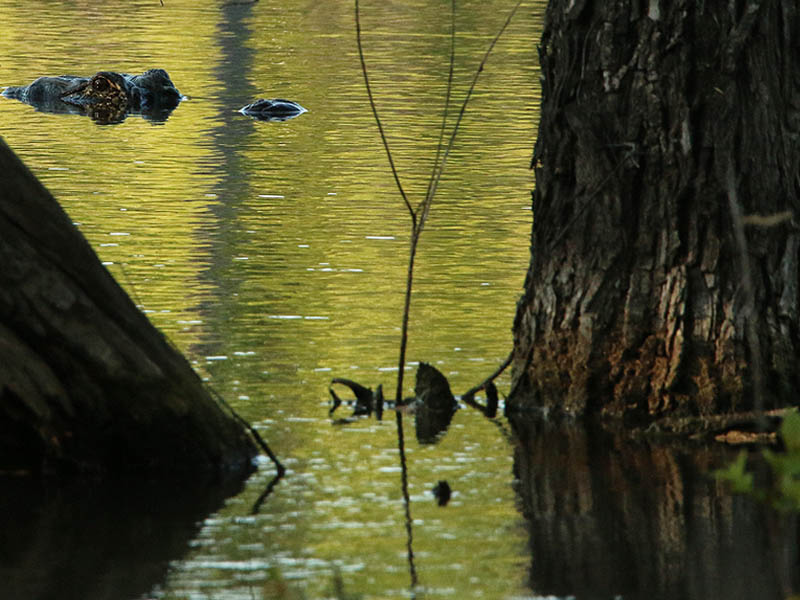
Alligators can grow to become quite large. Fully grown Alligator can range from 10 to 15 feet in length and can weigh anywhere from 400 to 1100 pounds. Males are typically larger than females, with males averaging 11 feet in length and 790 pounds, while adult females generally come in around 8 feet and 200 pounds.
Alligator mating season occurs during the warmer months of spring and summer. Courtship begins in late spring and early summer. Eggs are laid in nest mounds made of mud and vegetation in mid-summer, and juvenile Alligators hatch in August and September.
Alligators are opportunistic predators, and they feed on the wide variety of different animals found in their usual wetland habitats. See the blurb below for how Wikipedia describes the typical diet of American Alligators. Most of these animals are abundant in North Texas as well.
A few examples of animals consumed are largemouth bass, spotted gar, freshwater pearl mussels, American green tree frogs, yellow mud turtles, cottonmouths, common moorhens, and feral wild boars. Stomach contents show, among native mammals, muskrats and raccoons are some of the most commonly eaten species. In Louisiana, where introduced nutria are common, they are perhaps the most regular prey for adult American alligators, although only larger adults commonly eat this species
Wikipedia
American Alligators are found throughout the southeastern United States, with a distribution that follows the Gulf and Atlantic coasts from Texas around Florida, and up to North Carolina. Alligators can be present inland for several hundred miles across much of their range, in locations with suitable habitat. Alligators prefer wetland areas, and can be expected to occur in places such as swamps, bogs, rivers, creeks, ponds, and lakes.
In Texas, Alligators range widely across the southern and eastern parts of the state. See the map to the right for Texas Parks and Wildlife Department’s assessment the Alligator’s distribution throughout the state. This map was produced in 2002. The areas shaded in green denote the parts of Texas where Alligators are expected (significant portions of the Dallas/Fort Worth Metroplex included). The highest populations density of Alligators occur in areas on the map colored dark green. Conditions and habitat are generally better for Alligators in these parts of the state. Limited and scattered populations are more typical in the less hospitable light green areas. There is some speculation that when Alligators are found outside these areas, they may be members of remnant populations or released animals.
In my attempt to unravel the mystery surrounding DFW Alligators, I began by researching reported sightings online. It turns out that there is an ample number of Dallas/Fort Worth area Alligators sightings to be found.
Reported sightings found on the internet only go back to the early 2000’s. While I have distinct memories of DFW Alligators occasionally making the news as early as the 1980’s, those reports apparently have disappeared into the blackhole of forgotten news as far as the internet is concerned.
As I browsed through the search results, I kept only those that met certain criteria. Generally, reports had to come from reputable news services, but I also considered sightings from other sources if they included pictures with recognizable landmarks. Reports from known associates and/or known institutions often made the cut as well. Those reports vetted by experts received special consideration.
From this data some general conclusions can be made. For Instance, Alligator sighting occur most frequently between the months of March and September, but there is at least one outlier January observation reported in the dead of winter. Based on these sighting reports alone, and assuming that some of these are surely observation of the same Alligators, one can conclude that there are at least some 30-odd Alligators living here in the metroplex. And lastly, it is important to note that not a single report involved an Alligator attacking or otherwise harming people, pets, or livestock.
Reviewing the reports of Alligators sightings from around the metroplex, I found that most seem to be unremarkable. In the majority of cases, the habitats appeared to be good and there were ready avenues of access. But there were also a few outliers that are harder to explain–with some of these reports being downright bizarre. Observations from areas with isolated habitat–and with no obvious routes of ingress–were particularly puzzling.
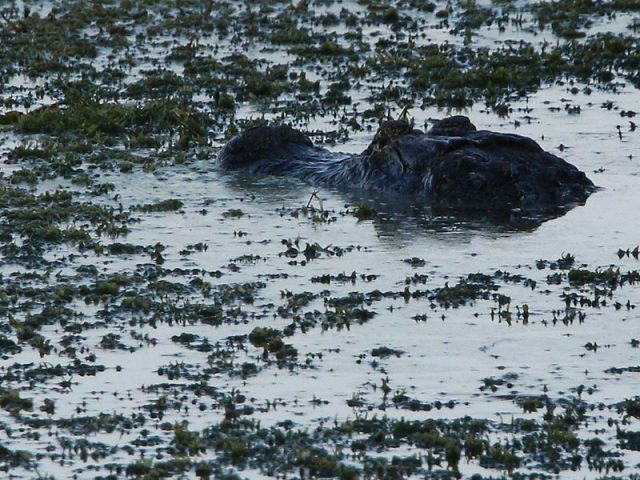
There are also notable gaps on the map where Alligators have not yet been reliable reported. The absence of Alligators in these places is difficult to explain. The various forks of the Trinity River and its many feeder creeks connect most of the known Alligators hotspots. These wildlife corridors are often densely wooded and remote even as they meander through the urban landscape. A good number of them include borrow pit lakes, which at first glance look like extraordinary Alligator habitat. In spite of this I found scant evidence connecting the dots.
Maybe there are urban Alligators in these places, and they have just not been reported. Many of these places are so remote and unforgiving that they are rarely visited by people, even though they are found right in the very heart of the city. Another factor is that Alligators can be hard to notice and easy to miss. I have a number of friends and associates who frequent these areas more often than I do. I always encourage them to keep an eye out, but so far any Alligators that may be present remain unobserved. Finally, it is always possible that Alligators really are absent from many places that otherwise might be considered prime habitat.
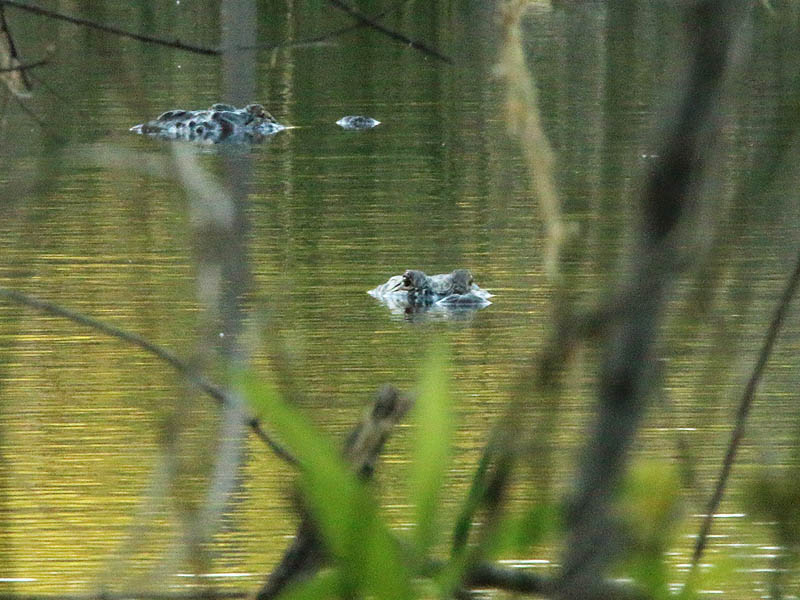
Whatever the case, our urban Alligators do appear to be shy and retiring. I’ve had a couple of encounters with Alligators here in the metroplex over the years, and in every case the Alligators fled at a sizeable distance as I approached. I believe this behavior is probably typical of wild Alligators in North Texas. This is the demeanor that might be expected from Alligators as long as they have not be habituated by people feeding them. Unfortunately, I have also seen some indications that at least some local Alligators are being fed. This is surely a bad idea. If Alligators and people ever come into conflict in DFW this will probably be the reason why. Here’s what Texas Parks and Wildlife has to say about Human-Alligator interactions…
With the human population in Texas continuing to expand, increased contact between people and alligators can be expected. Alligators naturally shy away from humans. Problems arise when alligators are fed by people. The alligator loses its fear of humans and begins to associate people with food. This produces a potentially dangerous situation. An alligator that has been frequently hand-fed will often lunge at an outstretched hand. This action is often interpreted as an “alligator attack.” In reality, the alligator has been conditioned to respond to an outstretched hand, expecting to be fed. For this reason feeding of any wild alligator is not recommended. The normally sluggish alligator can become quite agile if unexpectedly disturbed or annoyed. People and pets should not approach alligators closely. This is particularly true of nesting females. As with all wild animals, alligators should be treated with respect. Alligators are protected by law. Any potentially dangerous alligator should be reported to Texas Parks and Wildlife Department so that proper handling can be initiated. Contact your local game warden or call 1-800-792-1112.
Texas Parks and Wildlife Department
While we all know that Alligators are powerful predators that deserve our respect, the evidence would suggest that the risk posed by these big reptiles in DFW is minimal in most cases. But that does not mean a danger does not exist. Always be cognizant that Alligators may be present in places with suitable habitat in North Texas, and exercise the appropriate level of caution when in these kind of areas. And never, ever feed wild Alligators!
Below you will find a map of Dallas/Fort Worth with a compilation of the data I collected overlaid. The map shows the general location of Alligator sightings around the metroplex. Beneath the map I have listed the date, source, and summary of each reported sighting for each location on the map. You will notice quickly that there are several Alligator hotspots in DFW.
This list is surely not comprehensive. Right now, it only contains readily available information about observations found on the internet. Certainly, there have been many additional Alligator sightings in North Texas over the years. Going forward, I will try to update this article and the accompanying map/table as new information becomes available. If you have seen an Alligator somewhere in the Dallas/Fort Worth Ten-County Area–and that sighting is reasonably verifiable–we would love to hear about it so that it can be added to this record. Email or Facebook messaging are the best ways to reach us!

LOCATION 1
- Aug 09, 2002 – News Report – Alligator Found Near Dallas ISD High School Practice Field
LOCATION 2
- Apr 15, 2009 – iNaturalist Observation – Alligator Seen in the West Fork of the Trinity River
- May 24, 2012 – News Report – Alligator Killed by Fishermen
- Jun 6, 2016 – News Report – Alligator Observed in Tarrant County Lake
- Jun 17, 2016 – News Report – Concerns About a Blind Alligator Living in Area Lake
- Aug 6, 2019 – News Report – Game Warden Discovers Alligator Killed by Poachers
- May 30, 2021 – News Report – Alligators Photographed on the Trinity River
- May 10, 2022 – News Report – Alligator Observed Swimming in Tarrant County Lake
LOCATION 3
- May 27, 2010 – News Report – Alligator Found in Arlington Park
LOCATION 4
- May 15, 2011 – Blog Post – Trinity River Alligators in Dallas County
LOCATION 5
- Jun 12, 2011 – YouTube Video – Two Alligators Dead, Entangled in Soccer Net
LOCATION 6
- Mar 21, 2012 – News Report – Alligators Seen Near Fort Worth-Area Lake Dam
- May 20, 2019 – News Report – Alligator on Road Blocks Traffic
- Apr 10, 2020 – iNaturalist Observation – Alligator Seen in Area Lake
LOCATION 7
- Apr 5, 2012 – News Report – Alligator Spotted in Area Lake
- Jul 7, 2016 – Municipality Website – Alligator Reported in Tarrant County Lake
- Apr 4, 2018 – News Report – Alligator Observed at Lake in Tarrant County
- Jan 25, 2022 – Municipality Website – Resident Reports Alligator Seen in Area Lake
LOCATION 8
- Apr 19, 2014 – iNaturalist Observation – Alligator Photographed in Nature Preserve
- April 22. 2014 – Blog Post – American Alligators Found in Denton County
- May 05, 2014 – Blog Post – Comparing the Size of Two North Texas Alligators
- Jun 17, 2015 – Magazine Article – Nine-Foot Long Alligator in Denton County
- Jul 1, 2016 – Blog Post – Alligator Living in Area Nature Preserve
- Apr 28, 2019 – Blog Post – Multiple Alligators Observed in Denton County
LOCATION 9
- Jul 11, 2014 – Facebook Page – Alligator Photographed in Kaufman County Nature Preserve
- Sep 30, 2014 – Facebook Page – Nature preserve Reports Continuing Alligator Sightings
LOCATION 10
- Jul 24, 2014 – News Report – Lake Resident Reports Alligator Sighting
- Aug 2, 2014 – News Report – Alligator Sighting Reported in Local Lake
- Aug 19, 2018 – YouTube Video – Swimming Alligator Recorded by Fishermen
LOCATION 11
- Jun 26, 2015 – News Report – Alligator Spotted Near Downtown Fort Worth
- Jul 9, 2015 – News Report – Blind, 10-foot Alligator Captured Near Downtown Fort Worth
LOCATION 12
- May 25, 2016 – News Report – Alligator Found Near Dallas Middle School
LOCATION 13
- Jul 7, 2016 – News Report – Alligator Shot and Killed
LOCATION 14
- Jun 5, 2019 – Facebook Profile – Alligator Recorded While Crossing Busy Street
- Jun 8, 2019 – YouTube Video – Alligator Found Shot and Bleeding in the Road
LOCATION 15
- Jun 8, 2020 – Municipality Website – Alligator Observed in City Nature Preserve
LOCATION 16
- Mar 29, 2021 – News Report – Alligator Seen by Drone in Wetland Near Residential Subdivision
- Jun 4, 2021 – News Report – Alligator Observed Crossing Highway Service Road
LOCATION 17
- Sep 7, 2021 – News Report – Alligator Captured in East Dallas Neighborhood
LOCATION 18
- Jul 22, 2022 – iNaturalist Observation – Alligator Found in Borrow Pit Lake Near Trinity River
- Jul 28, 2022 – iNaturalist Observation – Alligator Photographed Close to Trinity River
- Jul 30, 2022 – iNaturalist Observation – Continuing Observations of Previously Reported Alligator
- Aug 12, 2022 – iNaturalist Observation – Alligator Recording Basking on Banks of A Borrow Pit Lake
LOCATION 19
- Sep 2, 2022 – News Report – Policed Called about Alligator in Bank Parking Lot
LOCATION 20
- Mar 17, 2024 – Instagram – Fisherman Spots Alligator in Borrow Pit Lake
- Jul 10, 2024 – City of Coppell reports Alligator observed in Denton Creek


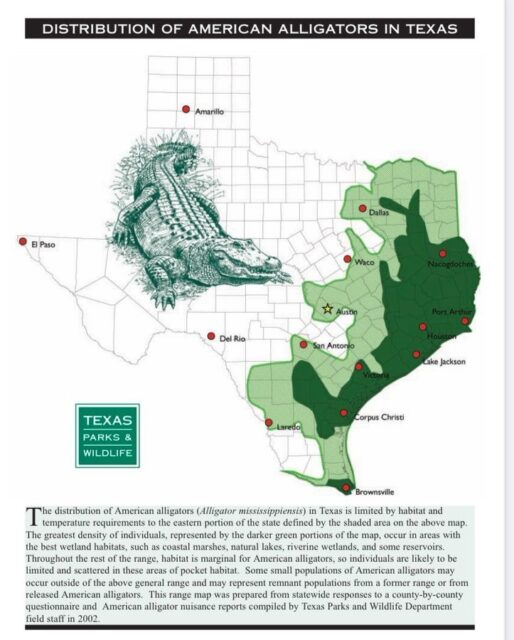




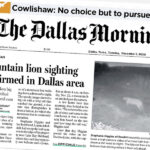
I always enjoy your meticulous research and conclusions, Chris.
Nice report Chris. I wonder how many of these ‘gators could be the result of people who have in some way acquired a “pet” ‘gator, and then became disenchanted with having such a beast in the bathtub or back yard pool? However, iirc, alligators were reported to be present in the Dallas area prior to urbanization, then absent for decades. They are present in lower reaches of the Trinity in substantial numbers, and certainly could have naturally made their way north, especially as the climate has warmed.
EDITORS NOTE: I wonder that myself, David. I suppose the isolated populations might lend some credence to that idea, though I’m not 100% sure the populations really are as isolated as they appear. I’ve also never seen evidence that Alligators reproduce here. No nests. No juveniles. So far!